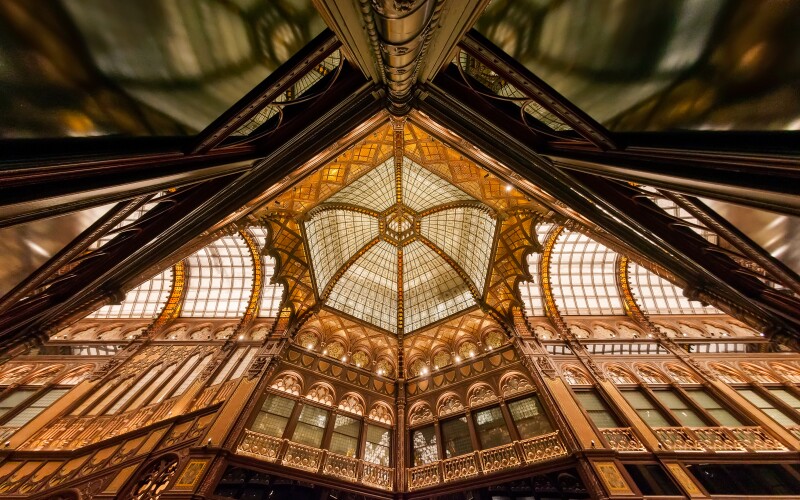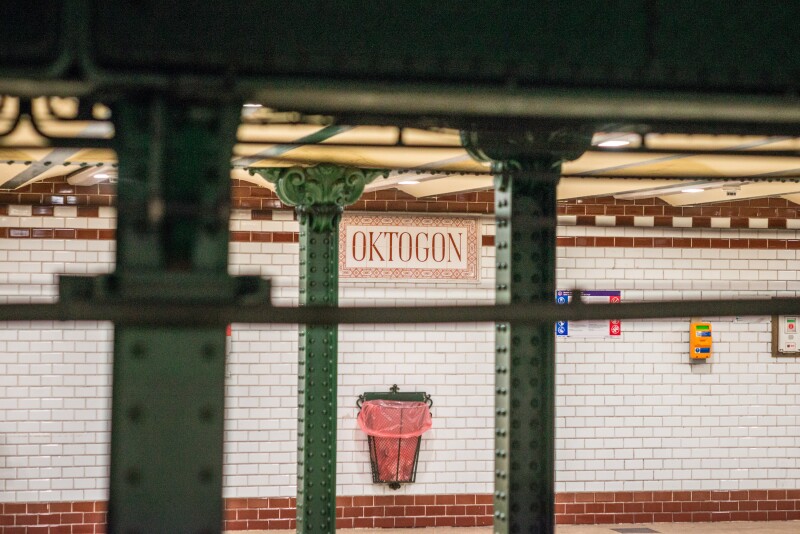Budapest is full of unexpected adventures. A versatile and cosmopolitan capital with a rich past, vibrant food scene, and thriving cultural life, the city invites travelers to step outside the norm. Explore colorful, community-driven street art in the Jewish Quarter. Hop aboard continental Europe’s oldest metro line. Search for the finest bottle of Hungarian wine in The Great Market Hall. No matter what path you choose, it’s bound to lead somewhere exciting. Read on to learn about the best of Budapest’s lesser-known treasures.
Feast at The Great Market Hall

The Great Market Hall
Courtesy of Visit Hungary
For a taste of Hungary’s delicacies, stop by The Great Market Hall, Budapest’s best-loved market with a wide array of fresh cheeses, meats, produce, and other delicacies. To navigate the building, which opened in 1897 and is more than 100,000 square feet with hundreds of stalls, it helps to have a plan. While the ground level is dedicated to ingredients (don’t miss the honey and paprika, Hungary’s favorite seasoning), the second level houses souvenirs, handicrafts, and food stalls where you can sample popular Hungarian dishes, such as goulash, stuffed cabbage, and hortobágyi palacsinta (a meat-filled pancake). There’s even a basement, which is where you’ll discover fine bottles of Hungarian wine.
Step back into the Belle Epoque

The Párisi Passage of the Parisi Udvar building
Courtesy of Visit Hungary
Housed in what was once Budapest’s first modern department store, the Párisi Udvar building evokes the elegance and luxury of the city’s social life at the turn of the 20th century. The ornate landmark has been restored to its former glory and remains an architectural marvel, decked out in stained-glass windows by Hungarian artist Miksa Róth and thousands of Zsolnay tiles from the famed factory in Pécs. Wander the Parisian Court interior, decked out in cast-iron and sculpted wooden ornaments, and sip champagne under the building’s iconic crystal dome.
Visit a historic thermal bath

Veli Bej
Courtesy of Visit Hungary
Those looking to experience Budapest’s thermal bath culture without the crowds will find a hidden treasure at Veli Bej, one of the city’s smaller spas. But don’t let its size fool you—Veli Bej has plenty to offer. Built during the Ottoman era, it recently reopened after a major renovation to modernize its treatment facilities. In addition to the beautifully restored, domed bath complex, which dates to the 16-century and includes a large octagonal, hot-water thermal pool, the spa is outfitted with four smaller pools at different temperatures, two steam chambers with massage showers, and a Jacuzzi, a swimming pool, a Kneipp walk pool, and a Finnish and infrared sauna.
Discover street art in the Jewish Quarter
Budapest’s street art scene is more alive than ever—nowhere more so than in the Jewish Quarter, where buildings that were damaged during WWII and left in ruins for decades are being revitalized with kaleidoscopic murals. Budapest commissioned local and international artists to cover the buildings with contemporary art, while collectives put on annual art festivals. Take a self-guided tour around the neighborhood, stopping at a few postcard-worthy favorites like Dan Ferrer’s Alice, a representation of the potential of children and an allusion to Alice in Wonderland, and urban art collective Neopaint’s tribute to the Hungarian inventor of the Rubik’s Cube.
Ride continental Europe’s oldest metro line

Millennium Underground Railway
Courtesy of Visit Hungary
Head beneath the city streets and board Budapest’s Metro line M1, the oldest subway in continental Europe and the world’s first electrified underground railway system. In constant operation since 1896, the fabled yellow cars run under many of Budapest’s UNESCO-protected areas, including Andrássy Avenue, from downtown Vörösmarty Square to just past City Park, and playing a vital part in the city’s history and present-day life.
To learn more about the M1, also known as the “Millennium Underground” due to its role in the 1896 celebrations marking the 1,000th anniversary of the Hungarian conquest of the region, stop by the Millennium Underground Museum. It’s packed with original carriages, models, graphs, and maps that tell the metro’s story.











